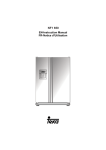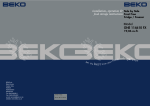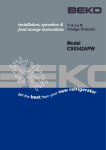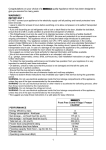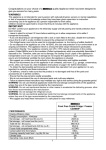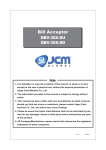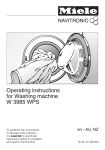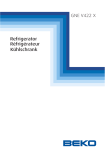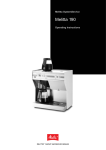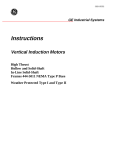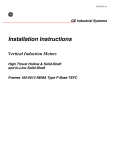Download Beko AP930 User manual
Transcript
Side by Side Frost Free Fridge / Freezer AP930 20.2 cu.ft. BEKO plc Beko House Caxton Way Watford Hertfordshire WD18 8UF Tel: 01923 654650 Fax: 01923 819653 e-mail: [email protected] website: www.beko.co.uk Printed in Turkey Part no: 48 4271 00 02 Revision no: 2 Congratulations on your choice of a service for many years. quality Appliance which has been designed to give you WARNING ! IMPORTANT ! DO NOT connect your appliance to the electricity supply until all packing and transit protectors have been removed. • Leave to stand for at least 4 hours before switching on to allow compressor oil to settle if transported horizontally. • If you are discarding an old refrigerator with a lock or latch fitted to the door, disable the lock/latch, ensure that it is left in a safe condition to prevent the entrapment of young children. • This fridge/freezer must only be used for its intended purpose i.e. the storing and freezing of edible foodstuff. • We suggest you contact your local authority for disposal information and facilities available. • We do not recommend use of this appliance in an unheated, cold room. (E.g.: garage, conservatory, annex, shed, out-house etc.) See Installation Instructions on page 4 for further information. • To obtain the best possible performance and trouble free operation from your appliance it is very important to carefully read these instructions. • On delivery, check to make sure that the product is not damaged and that all the parts and accessories are in perfect condition. • Ensure that the plug remains readily accessible. Do not use multiple adapter bar or extension cable. • Failure to observe these instructions may invalidate your right to free service during the guarantee period. WARNING- Keep ventilation openings, in the appliance enclosure or in the built-in structure, clear of obstruction. WARNING- Do not use mechanical devices or other means to accelerate the defrosting process, other than those recommended by the manufacturer. WARNING- Do not damage the refrigerant circuit. WARNING- Do not use electrical appliances inside the food storage compartments of the appliance, unless they are of the type recommended by the manufacturer. • Do not touch moving parts like the slushed ice cutter in the Ice cube container . • We suggest you keep these instructions in a safe place for easy reference. Frost Free Fridge Freezer • BEKO plc declines to accept any liability should the instructions not be followed. AP930 PERFORMANCE Energy efficiency class Energy consumption - Kwh/year Net storage - vol fresh food ltrs (cu.ft.) Net storage - vol frozen food ltrs (cu.ft.) Two star section Total net vol - ltrs (cu.ft.) Frozen food compartment rating Conservation time from failure Freezing capacity fresh food - kg (lb) / 24 hrs. Climate class Operating noise level dB(A) 1 A 529 383 lt. (13.5) 146 lt. (5.2) 6 lt. (0.2) 535 lt. (18.9) 4 STAR 8 h. 13 SN 46 TRANSPORTATION INSTRUCTIONS 4 INSTALLATION INSTRUCTIONS 4-11 STARTING 12 STORING FRESH FOOD 13 FRIDGE COMPARTMENT STORAGE ADVICE 13 STORING PRE-FROZEN FOOD 14 GETTING TO KNOW YOUR FROST FREE FRIDGE FREEZER 15-16 USING THE ACCESSORIES 17-21 SUGGESTED ARRANGEMENT OF FOOD IN THE FRIDGE/FREEZER 22-23 TEMPERATURE CONTROL AND ADJUSTMENT 24-26 STORING FROZEN FOOD 27 FREEZING FRESH FOOD 27 DEFROSTING 27 CLEANING AND CARE 28 REPLACING THE INTERIOR LIGHT BULB 29 DO'S AND DON'TS 30 ENERGY SAVING TIPS 31 PROBLEM SOLVING AND TROUBLE SHOOTING 31-36 GUARANTEE DETAILS 37 HOW TO OBTAIN SERVICE 38 2 WARNING! THIS APPLIANCE MUST BE EARTHED If the fitted moulded plug is not suitable for your socket, then the plug should be cut off and an appropriate plug fitted. Destroy the old plug which is cut off as a plug with bared cord could cause a shock hazard if inserted into a socket elsewhere in the house. The moulded plug on this appliance incorporates a 13 A fuse. Should the fuse need to be replaced an ASTABEAB approved BS 1362 fuse of the same rating must be used. Do not forget to refit the fuse cover. In the event of losing the fuse cover the plug must not be used until a replacement fuse cover has been fitted. Colour of the replacement fuse cover must be the same colour as that visible on the pin face of the plug. Fuse covers are available from any good electrical store. IMPORTANT! FITTING A DIFFERENT PLUG As the colours of the wires in the mains lead of this appliance may not correspond with the coloured markings identifying the terminals in your plug proceed as follows: (See diagram). 1. Connect the green-yellow or green (Earth) wire to the terminal in the plug marked 'E' or with the symbol or coloured green and yellow or green. 2. Connect the blue (Neutral) wire to the terminal in the plug marked 'N' or coloured black. GREEN & YELLOW OR GREEN 6mm. N BLUE OR BLACK L BROWN OR RED 22mm. CORD GRIP FITTED WITH BS 1362 13A FUSE ALWAYS FIT BS 1362 REPLACEMENT CARTRIDGE FUSE 4 FUSE PLUMBING REQUIREMENTS 6mm. 3 12mm. ELECTRICAL REQUIREMENTS ELECTRICAL REQUIREMENTS Before you insert the plug into the wall socket make sure that the voltage and the frequency shown in the rating plate inside the appliance corresponds to your electricity supply. Rating label is on the left hand side of fridge inner liner. We recommend that this appliance be connected to the mains supply via a suitable switched and fused socket. The appliance must be positioned so that the plug is accessible. Should the mains lead of the appliance become damaged or should it need replacing at any time, it must be replaced by a special purpose made mains lead which can only be obtained from a BEKO Authorised Service Agent. 32mm. PAGE 6mm. CONTENTS 3. Connect the brown (Live) wire to the terminal in the plug marked 'L' or coloured red. With alternative plugs a 13 A fuse must be fitted either in the plug or adaptor or in the main fuse box. If in doubt contact a qualified electrician. 3 PLUMBING REQUIREMENTS In order to operate the automatic ice maker/dispenser and chilled water dispenser, you will need to get your appliance plumbed into the cold mains water supply in your house via a standard 1/2 “ valve fitting. If in doubt contact a qualified plumber and your local water company. See page 9. TRANSPORTATION INSTRUCTIONS 1. The appliance should be transported only in a vertical upright position. The packing as supplied must be intact during transportation. 2. If during the course of transport the appliance has to be transported horizontally, it must only be laid on its left hand side when standing in the front of the appliance. After bringing it to upright position,it must not be operated for at least 4 hours to allow the system to settle. 3. Failure to comply with the above instructions could result in damage occuring to the appliance. The manufacturer will not be held responsible if these instructions are disregarded. 4. The appliance must be protected against rain, moisture and other atmospheric influences. 5. When positioning your appliance take care not to damage your flooring, pipes, wall coverings etc. Do not move the appliance by pulling by the door or handle. 6. Empty any water in the drain tray before moving. See section ‘Care & cleaning’ for further information. 3. Do not place the appliance near cookers, radiators or in direct sunlight as this will cause your appliance to work harder. If installed next to a source of heat or freezer, maintain the following minimum side clearances: From Cookers 50 mm (2") From Radiators 300 mm (12") From Freezers 25 mm (1") From Wall 50 mm (2") 4. Adjustable feet adjustment for levelling If your refrigerator is not level, you can level it by turning the front feet as illustrated in the figure below. The corner where the feet is lowered when you turn in the direction of black arrow and raised when you turn in the opposite direction. You may need somebody to help you to slightly lift the refrigerator off the floor for a few centimeters. Take care when lifting the appliance because it is very heavy. Do not attempt to sit or stand on top of your appliance as it is not designed for such use. You could injure yourself or damage the appliance. IMPORTANT: Make sure that mains cable is not caught under the appliance during and after carrying / moving the appliance, to avoid the mains cable becoming cut or damaged." Do not allow children to play with the appliance or tamper with the controls. IMPORTANT INSTALLATION INSTRUCTIONS 1. The space in the room where the appliance is installed must not be smaller than 10 cubic metres. 2. Do not put your fridge freezer in a cold room where the temperature is likely to go below +5 degrees C (41 degrees F) during night time and/or especially in winter. This fridge freezer has been designed to operate in ambient temperatures between +5 and +32 degrees C (41 and 90 degrees F) Therefore if the appliance is installed in an unheated/cold room (eg: conservatory/annex/ shed/garage etc) then the appliance will not operate causing the freezer compartment to run warmer and as a result the storage time of frozen food may be reduced. 4 5. Door height adjustment If there is a misalignment between the doors, perform the steps indicated below to adjust door heights: Doors can be raised vertically. This process can be performed easily using a flat tipped screwdriver and an allen key (M6) as illustrated in the following figures. Door racks should be removed when adjusting the door height. • Remove the screws fastening the lower cover using a flat tipped screwdriver in the order shown in the figure. 4 1 2 3 5 • Loosen the 3 screws of the lower door hinges using a flat tipped screwdriver. (Do not remove completely) BEFORE FIRST USE & OPERATION Ice/Water Dispenser • The minimum inlet water pressure required is 1 bar • The maximum inlet water pressure allowed is 8 bars • The appliance must be connected to the cold mains water supply and must never be connected to the hot water. •Make sure the anti-condensation switch underneath the display is pressed after connecting the appliance to the cold mains water supply. (Factory setting is in pressed position) • If the freezer compartment door is lower than the fridge compartment door, bring them to the same level by turning the elevation screw on the freezer compartment side in the direction of arrow using a M6 allen key in the similar way as explained above on the opposite side. • You will need to wait for 12 hours before you get your first ice cubes from the ice dispenser. If there is less than 16 ice cubes in the ice cube container, ice dispenser may not operate. • The dispenser will not be activated if the freezer door is open. Therefore, please make sure that the freezer door is closed in order to allow the dispenser to start operating. • In order for the ice/water dispenser to operate smoothly, the water pressure in the system should be between 1 – 8 bars. To check this, see if 1 glass of water (100 cc) fills using the dispenser in 10 seconds. • Do not forget to take out the Ice Hole Cover before using the ice dispenser. • Water dispenser is automatically activated when the refrigerator starts operating. However it would take up to 12 hours for the water to chill. • Approximately the first 30 pieces of the ice cubes made and dispensed should not be consumed. • Water may not flow from the dispenser during the initial operation because of the air trapped in the piping system. Press the latch for about 1 minute three times at intervals to bleed the air trapped in the system. The uneven flow of the water from the dispenser will disappear as soon as the trapped air in the system is released. • The first 10 glasses of water should not be consumed. • Always make sure that you fit the water filter before using the ice/water dispenser. • If the freezer compartment door is higher than the fridge compartment door, bring them to the same level by turning the elevation screw on the fridge compartment side in the direction of arrow using a M6 allen key as illustrated below: After doing the above adjustments, the doors should be level. If the doors do not close properly, this might adversely affect the operation and efficiency of the refrigerator. 6 7 • First Check that the following items are supplied with appliance. Water Tube Nut Water Tube 2 1. 5-meter long water pipe (1/4 inch in diameter) 2. Nut for connection of the water pipe to the rear of the appliance 3. Cold mains water valve with mesh filter 4. 3 pieces of pipe clips (In case required to secure the water pipe) 5. Water Filter to be fitted to the bracket inside the fridge compartment. 1 3 1 Connecting the water pipe to the cold mains water supply 1. Separate the nut from the valve adaptor. 2. Connect the valve adaptor to the Feed Valve as shown in the figure. 3. Connect the water pipe to the valve adaptor and offer the nut to the valve adaptor as shown in the figure. 4. Tighten the nut manually. In case of a leak use a spanner or a pair of pliers to tighten the nut. Mesh Filter Tap Adaptor 4 2 5 Main Cold Water Line Nut Tap Adaptor Feed Valve Figure 1 Figure 2 Connection to the Cold Mains Water Valve Tap Adaptor Please follow the instructions below Nut Water Pipe MAKE SURE THAT STANDARD 1/2” VALVE FITTING FED BY COLD MAINS WATER SUPPLY IS AVAILABLE AND IS TURNED OFF FULLY. Connection of the water pipe to the refrigerator 1. Connect the water pipe to the inlet at the rear of the appliance as shown in the figure below. 2. Fix the nut to the valve as shown in the figure. 3. First offer the nut to the water pipe. Then push water pipe down firmly in to the inlet fitting. Then tighten the nut manually. You should not need to tighten the nut with a tool to achieve water tight assembly. In case of a leak use a spanner or a pair of pliers to tighten the nut. 8 Figure 3 Secure the 5-meter water pipe to suitable points by means of the pipe clips supplied to avoid any damage or displacement or accidental disconnection. Warning: After turning on the water valve, make sure that there is no leakage at both connection points of the water pipe. In case of a leak, turn off the valve immediately and tighten all joints again using a spanner or a pair of pliers. 9 Water Filter Water Tubes Bypass Cover Water Tubes Bypass Cover Water filter should be replaced every 6 months. Water filter warning on the display will come on after about 6 months. The warning light remain on for about 15 days before it starts to flash. Once the filter has been replaced, this warning light can be cancelled by pressing the “Auto Eco” button on the display for 5 seconds. The water filter must be removed as shown in the figure when it is going to be replaced or when it will no longer be used. Make sure that the “Ice off” mode is active before removing the water filter. Filter To fit the water filter follow the instructions below referring to diagrams supplied: 1. Take out the upper salad crisper in the fridge as shown in the figure. 2. Unscrew the water filter by-pass cover. Warning: Make sure that the “ice off” mode is active before taking out the by-pass cover. Note: It is normal for a few drops of water to drip after the cover has been removed. 3. Remove the red cap on the top of the water filter cartridge and fix it to its place as shown in the figure. 4. Press “Ice off” button on the display again to exit from this mode. If you do not want to use the water filter, warning light should be cancelled. To do this, “Freezer Set” and “Water/Ice Selection” buttons must be pressed simultaneously for 2 seconds. Filter warning will flash for 5 times when pressed in this way and the warning will be cancelled. Filter warning will flash for 10 times when the same buttons are pressed for 2 seconds and the warning will be reactivated. Warning: Water filter is for cleaning some foreign particles in the water. It does not purify water from micro-organisms. Warning: “Ice off” button must always be pressed while replacing the water filter or installing the bypass cover. Water Reservoir If you wish to disassemble the water reservoir from the refrigerator for cleaning purposes follow the below instructions; Water Reservoir (Capacity is 0.9 L) • Remove the 2 screws by using a cross headed screwdriver as shown in the figure. • Gently hold and remove the water reservoir shown in the figure. Warning: 1 2 3 10 Never remove the nuts fitted to the water reservoir after cleaning the area behind the water reservoir, gently refit and check that there is no water leak. If you over tighten the nuts, it may cause leakage. 11 STARTING SUGGESTIONS FOR STORING FRESH FOOD Final Check Before you start using the fridge/freezer check that: Meat & poultry- Best stored in the Chiller Compartment (See page 21) 1. 2. 3. 4. The feet have been adjusted so that the product is level. The interior is dry and air can circulate freely at the rear of the cabinet. Clean the interior as recommended under "CLEANING AND CARE." Insert the plug into the wall socket and switch on the electricity supply. • When the door is open the respective interior light will come on. 5. You will hear noise as the compressor starts up. The liquid and gases sealed within the refrigeration system may also give rise to noise, whether the compressor is running or not which is quite normal. “Due to the operation of fans inside the appliance, overall noise level is slightly higher in comparison to non-frost free appliances. This is quite normal and is not a fault.” 6. Front edges of the cabinet may feel warm. This is normal. These areas are designed to be warm to avoid condensation. 7. "Do not load the appliance immediately it is switched on. Wait until the correct storage temperature has been reached. (See page 24) 8. When the compartments reach the desired temperatures fans will stop. When the freezer fan is on, the noise will be louder when the freezer door is opened. 9. Avoid spillage of food particularly small items like rice, peas, beans through the fan guard and air flow vents as they may cause the cooling system to block and therefore operate less efficiently. 10. The factory set temperature is +4°C for fridge compartment and -18°C for freezer compartment. 11. The compressor will start running approximately 5 minutes after the refrigerator is plugged in to protect the electronic components of your appliance. After start up of the compressor, compartment temperatures will reach the set temperatures in 24 hours depending on the ambient temperature and load in your refrigerator. 12. Pay attention to the following points during the first 24 hours of the operation: - Do not open the doors frequently. - Do not overload your refrigerator. - Do not put hot food. 12 • Wrap raw meat and poultry loosely in polythene bags or aluminium foil. This prevents drying. • Wrap fish and similar items in polythene bags to avoid drying and odour. Dairy Products • Wrap cheese firstly in greaseproof paper and then in polythene bag excluding as much air as possible. For best results take out of the fridge compartment an hour before eating. • Wrap bread well to keep it fresh. Fruit & vegetables • Take off any unusable leaves on vegetables and wipe off any soil. • Leave lettuce, cabbage, parsley and cauliflower on the stem. • Wrap pineapples, melons, cucumbers, tomatoes and similar produce in polythene bags as these types of produce may suffer damage if kept at very low temperatures. • Wrap food, which has a strong odour, or can dry out, in polythene bags, aluminium foil, or place in an airtight container. FRIDGE COMPARTMENT STORAGE ADVICE Fruit & vegetables • Don’t store bananas. • Don’t store melon - it can be chilled for short periods as long as it is wrapped to avoid it flavouring other food. • Wrap food affected by temperatures near 0°C (pineapples, salads, cucumbers, tomatoes etc.) in polythene bags to avoid freezing. Meat & poultry • Store raw meat and poultry below cooked food and dairy products. • Do not allow raw meat to come into contact with cooked food to avoid contamination. For safety, only store raw meat for two to three days in the Chiller Compartment. General • Cooked dishes must be stored in airtight covered containers. • Don’t store cooked and fresh food together in the same container. • Always allow hot food and beverages to cool first. • Leftover canned food should not be stored in the can. • Place chilled cooked food and similar food in the Chiller Compartment. • Keep food for as short a time as possible and adhere to ‘best before’ and ‘use by’ dates. • Don’t let defrosting food or food juices drip onto other food. 13 STORING PRE-FROZEN FOOD - See also page 27 • Take special care not to mix with fresh and thawed food. • The recommendation for (4 star means -18°C or colder) storage as stated on the food packaging must always be followed. • Pre-packed frozen food should be stored in accordance with the food manufacturer’s instructions for a frozen food storage compartment. • To ensure that the high quality achieved by the food manufacturer and retailer is maintained: 1 Wrap packets when you buy them. 2 Put packets in the freezer as quickly as possible after purchase. 3 Ensure that contents are labelled and dated. 4 Do not exceed ‘use by’ and ‘best before’ dates. GETTING TO KNOW YOUR FROST FREE FRIDGE / FREEZER AP930 WITH PLUMBED IN ICE MAKER/DISPENSER AND WATER DISPENSER 1 3 5 6 7 Amounts • Do not exceed the freezing capacity which in a 24 hour period is 13 kg. • Prepare fresh food in small portions to ensure rapid freezing. Do not freeze too large a quantity at any one time. The quality is best preserved when the food is frozen right through to the core as quickly as possible. • When freezing the maximum amount press the Fresh Freeze button. • When freezing small amounts, i.e. 2 kg (5lbs) there is no need to press the Fresh Freeze button. 6 Freezer compartment storage info/advice • Do not leave frozen food at room temperature to thaw; the best way to defrost food is to put it in the fridge to thaw slowly. Make sure you avoid defrosting food or food juices drip onto other food. • The freezer compartment is rated and suitable for the freezing and storage of pre-frozen food. • Don’t freeze filled bottles or sealed cans containing fizzy (carbonated) drinks as they may burst. • Check contents of the freezer every so often to make sure items are not stored for too long. • Don’t close the freezer door before placing the drawers in place. • Don’t try to keep frozen food which has thawed, it should be eaten within 24 hours or cooked and re-frozen. • If there is a power failure do not open the door. Frozen food should not be affected if the failure lasts for less than 8 hours. If the failure is longer, then the food should be checked and either eaten immediately or cooked and then re-frozen. • Placing warm food into the freezer compartment causes the compressor to operate continuously until the food is frozen solid. This can temporarily lead to excessive cooling of the fridge compartment. Serving • Don’t remove items from the freezer with wet hands. • Don’t give children ice cream direct from the freezer. The low temperature may cause ‘freezer burns’ on lips. • Products such as flavoured ice lollies should not be consumed too cold for the same reason. • Defrost food from the freezer in the fridge compartment. 14 14 12 13 4 FREEZING FRESH FOOD - See also page 27 • Take special care not to mix with already frozen food. • Always choose high quality fresh food and be sure it is thoroughly clean. • You can place food to be frozen in any compartment in the freezer. Preparation • Wrap food in aluminium foil or freezer quality polythene bags. • Wrap fish and similar items in polythene bags. • Wrap food which has a strong odour or can dry out, in polythene bags, aluminium foil, or place in airtight containers. • Make sure all air is excluded from foil wrapping or bags. 2 14 15 14 12 6 20 8 12 8 20 18 8 22 17 21 1 2 3 4 5 6 7 8 9 10 11 12 9 19 16 10 11 21 Freezer compartment Fridge compartment Fresh Freeze compartment Ice cube container Freezer Compartment interior light Freezer Compartment glass shelves Ice hole cover Freezer compartment drawers Kick plate Humidity adjustment slider Crisper cover Fridge Compartment glass shelves 13 14 15 16 17 18 19 Egg tray Fridge Compartment door racks Fridge Compartment interior light Snack tray Salad crisper Crisper or Chiller Compartment Crisper or Chiller Compartment adjustment slider 20 Bottle racks with bottle gripper 21 Adjustable front feet 22 Wine rack 15 GETTING TO KNOW YOUR FROST FREE FRIDGE / FREEZER USING THE ACCESSORIES Water/Ice Dispenser With its three different functions, the dispenser efficiently meets your chilled cold water and ice cube needs without having to open the door of the refrigerator. It is a continuous cold water and ice source without manually adding water. User friendly control panel provides the following dispensing functions: • Ice Cube TOP COVER: NEVER REMOVE THIS COVER • Crushed Ice • Chilled Water Note: • Water or ice can be dispensed for a maximum of 60 seconds at each use. • When the freezer door is open, the dispenser will not work. Using the Water Dispenser Main supply cable Warnings • It is normal for the first few glasses of water taken from the dispenser to be warm. Water pipe to ice maker Water pipe cover Cold water mains inlet valve REAR COVER: NEVER REMOVE THIS COVER • In cases where the water dispenser has not been used frequently, sufficient amount of water must be drained from the dispenser to get fresh water. Spillage Tray Water drops that drip during use, accumulates in the spillage tray. Remove the spillage tray by pressing down in the right corner. You can remove the water with a sponge or a soft cloth. 16 17 Using the Ice Dispenser Cleaning the Ice Container and the Water Dispenser Please note, first ice cubes will not be ready before 12 hours after switching on the appliance. If you don’t require ice cubes - for example in winter or during holidays away from home, turn on “Ice off” function. The ice maker produces approximately 120 pieces of ice cubes in 24 hours which can be dispensed as ice cubes or crushed ice. This amount may vary depending on certain conditions. It is normal to get crushed ice from the dispenser in a longer time than in getting the ice cubes and also flowing of some crushed ice before the ice cubes drop if crushed ice option had been selected before selecting ice cube option. Furthermore, in cases when no ice was taken from the dispenser for a long time, any difference in the smell and taste of the ice as well as having smaller pieces is very normal. If this is the case, the ice in the icebank should be emptied and the icebank must be cleaned thoroughly. Warnings • No ice should be added from outside to the icebank. This may adversely affect the ice supply or crushing the ice. • It is normal to have a couple of ice cubes stuck together in the icebank. • Moving parts such as blades in a housing at the ice outlet of the dispenser must not be touched to avoid injury. • Never use sharp objects to break the ice in the icebank. This may cause damage on the icebank. • Food stuff should never be placed into the icebank for quick cooling purposes. • If you see water droplets on the water dispenser or when you connect the appliance to the water system please make sure the anti-condensation switch underneath tne display is pressed. (Factory setting is in pressed position- See page 24) Ice off To stop ice formation, “ice off” button is pressed. When ice off is selected, no water will be taken into the Icematic. However, already existing ice can be taken from the dispenser. To restart ice formation, “ice off” button must be pressed again. Warning: If you do not use the ice dispenser, do not forget to put ice hole cover in to the chanfer inside of the freezer door. (See page 15) Follow the procedure and warnings below to clean the Ice Container: • Press “Ice off” key before taking out the Ice Container. • Remove the Ice Container by lifting first and then pulling towards yourself as shown in the diagram. • Empty the ice in the Ice Container if any. To take out the stuck ice, use objects that are not sharp to avoid any damage on the Ice Container. • Pay attention that the inside of the Ice Container is not wet/damp before placing it back to its housing. • After placing the Ice Container back to its housing and closing the freezer door, if you want to get ice from the ice dispenser, exit from “ice off” mode by pressing the “ice off” key again. • Do not touch moving parts like the knife in the Ice bank Humidity level control in the lower crisper/chiller compartment Humidity level can be adjusted by sliding the humidity adjustment slider to the right or left. • If you want to maintain humidity in this compartment, set the humidity adjustment slider to the closed position. (Left) • If you want to eliminate humidity in this compartment, set the humidity adjustment slider to the open position. (Right) Sliding shelves Sliding shelves can be pulled by about 4” to easily reach the food placed at the rear of the shelf and also for easier cleaning. 18 19 2. Pull 1. Lift Chiller Compartment Snack Tray Crisper or Chiller (0°C i. e. zero degree centigrade compartment (1) Snack tray can be used to store small items that you frequently use. Please take extra care not to damage the Snack Tray when you take it out of the fridge and place it back in the fridge gently. • The drawer at the bottom of the fridge compartment can be converted into a salad crisper or a Chiller Compartment. • The Chiller Compartment will keep the temperature below the temperature in the fridge compartment around 0°C and so, meat or fish can be kept fresher for longer. Active Ionizer Bacteria It is in the air channel of refrigerator back side of the crisper (3). With ionizing the air, airborne bacteria and the bad smell originated from these bacteria will be reduced. Ion Chiller Compartment is also ideal for the storage of ready cooked chilled food. Important: Crisper • Vegetables and fruits may freeze if the adjustment slider (2) is kept at Chiller Compartment position. Therefore, check the position of the slider (2) before storing food. • In ambient temperatures at 10°C or lower, green leaf vegetables and other easily frozen salad should be removed from this compartment (1) and placed into the upper crisper compartment. (3) • Do not swap the position of these drawers and make sure that the position adjustment slider is set at the desired position i.e. salad crisper or Chiller Compartment. Chiller • In ambient temperatures above 28°C, if the compartment (1) is required to be colder, the adjustment slider (4) in the freezer can be converted to open position. Be sure the adjustment slider (4) in the freezer is in close position when the ambient temperature is below 28°C. 20 21 SUGGESTED ARRANGEMENT OF FOOD IN THE FRIDGE/FREEZER Arrangement Examples (See diagram) 1. Baked, chilled cooked food. 2. Wine and similar items. 3. Meat, sausages, cold cuts - You may also use Chiller Compartment (4-b) to store these items 4. Fruit, vegetables, salads. (4-a, 4-b) 5. Fastest freezing compartment 6. Frozen food and freezing of fresh food. 7. Butter, cheese, eggs. 8. Small items 9. Tall bottles, beverages. 10. Dairy products, small packs. The following guidelines and recommendations are suggested to obtain the best results and storage hygiene. 1. The fridge compartment is for the short term storage of fresh food and drinks. 2. The freezer compartment is (4 star) rated and is suitable for the freezing of fresh food and storage of pre frozen food. The recommendation for storage as stated on the food packaging should be observed at all times. 3. Cooked dishes must be stored in airtight covered containers. 4. Fresh wrapped produce can be placed on the shelf. Fresh fruit and vegetables should be cleaned and stored in the crisper bins. 5. Bottles can be placed in the door section. 6. To store raw meat, wrap in polythene bags and place in the Chiller Compartment. Do not allow such items to come into contact with cooked food to avoid contamination. For safety, only store raw meat for two to three days. 7. Keep the food packed wrapped or covered. Allow hot food and beverages to cool before placing them in the fridge. Do not store explosive substances. High proof alcohol must be stored upright in sealed containers. Left over canned food should not be stored in the can. 8. Fizzy drinks should not be frozen and products such as flavoured water ices, ice lollies should not be consumed too cold. 9. Some fruit and vegetables suffer damage if kept at temperatures near 0°C for example in the Chiller Compartment. Therefore wrap pineapples, melons, cucumbers, tomatoes and similar produce in polythene bags and never place them in the chiller compartment. 10. Place chilled cooked food and similar food in the Chiller Compartment. 11. Shelves, racks, crisper bins, drawers, flaps, bottle grippers are all removable. 12. Do not leave frozen food at room temperature to thaw; the best way to defrost food is to put it in the fridge to thaw slowly. Make sure you avoid defrosting food or food juices drip onto other food. 13. For hygiene reasons, always wrap food using a suitable packaging material before storing in your appliance to avoid contact with the appliance surface. 22 10 1 5 7 8 9 3 6 9 2 4-a 4-b 23 Freezer Fridge Compartment Compartment Adjustment Adjustment TEMPERATURE CONTROL AND ADJUSTMENT Control buttons allow you to make the settings of your refrigerator easily and without opening the doors. Thus, coldness loss is avoided. Fridge Set/ Vacation button Freezer Set button Quick Cool button Fresh Freeze button Auto Eco button Ionizer / Key lock button Water Dispenser light button Water Dispenser lights -18°C -20,-22 or 24°C Fresh freeze Display will show -27°C -18°C or colder -18°C or colder Explanations 4°C This is the normal recommended setting. 4°C These settings are recommended when the ambient temperature exceeds 30°C. 4°C 2°C Quick cool Display will show +1°C Use this when you wish to freeze your food or make ice in a short time. Your refrigerator will return to its previous mode when the process is over. If you think that your fridge compartment is not cold enough because of the hot conditions or frequent opening and closing of the door. You can use it when your fridge compartment is overloaded or if you wish to cool down your food rapidly. Ice-off button Ice / Water selection button Anti-condensation switch Economy Mode Indicator Freezer temperature set indicator To change it, press the button and the temperature will go down by 2°C. Everytime you press it, it will go down and then around to the highest setting. Release at the desired temperature and the new set temperature will be stored. High temperature/ Error warning indicator Key lock indicator Freezer Temperature indicator Freezer door open indicator • Fridge temperature can be set at one of the following temperatures : 8,6,4 and 2°C Fridge Temperature indicator Fridge temperature set indicator Fridge door open indicator Making the fridge compartment temperature adjustment Making the freezer compartment temperature adjustment To change it, press the button and the temperature will go down by 2°C. Everytime you press it , it will go down and then around to the highest setting. Release at the desired temperature and the new set temperature will be stored. Filter indicator Vacation indicator • Freezer temperature can be set at one of the following temperatures : -18,-20,-22 and –24°C Fresh Freeze function -24 °C 2 °C -22 °C 4 °C -20 °C 6 °C -18 °C 8 °C Water indicator Auto Eco indicator Ionizer Cube-ice Fresh Freeze indicator When you press Fresh Freeze button, the compressor will run for about 24 hours. After pressing the Fresh Freeze button, you can load fresh food to be frozen. Fresh Freeze indicator will glow and freezer compartment temperature settings turns to –27°C whilst the Fresh Freeze is active. To cancel, press Fresh Freeze again and then Fresh Freeze indicator will go off and returns to normal settings. Fresh Freeze will cancel itself automatically after about 24 hours if you do not cancel it manually. Quick cool indicator Crash Ice indicator If you want to freeze large amounts of fresh food, press the fresh freeze button 24 hours before putting the food into the freezer compartment. Ice off indicator 24 25 SUGGESTIONS FOR STORING FROZEN FOOD Quick Cool Function When you press Quick Cool button, the temperature of the compartment will be colder than the adjusted values. This function can be used for food placed in the fridge compartment and required to be cooled down rapidly. After pressing the Quick Cool button, Quick Cool indicator will glow and fridge compartment temperature setting turns to 1°C whilst the Quick Cool is active. To cancel, press Quick Cool again and then Quick Cool indicator will go off and returns to normal settings. Quick Cool will cancel itself automatically after about 2 hours if you do not cancel it manually. Prepacked commercially frozen food should be stored in accordance with the frozen food manufacturer's instructions for a ( 4 star) frozen food storage compartment. To ensure that the high quality achieved by the frozen food manufacturer and the food retailer is maintained, the following should be remembered: 1. Put packets in the freezer as quickly as possible after purchase. 2. Ensure that contents are labelled and dated. 3. Do not exceed "Use By", "Best Before" dates on the packaging. Vacation: While fridge compartment is not going to be used for a long time, it can be arranged at a moderate temperature preventing the odor formation. To activate this, press the Vacation button for 2 seconds. While the function is active, plase do not leave the fridge compartment door open. If there is a power failure do not open the freezer door. Frozen food should not be affected if the failure lasts for less than 8 hrs. If the failure is longer, then the food should be checked and either eaten immediately or cooked and then refrozen. Auto Eco (Special Economy function) • If you remove home freeze drawer and ice bank to increase the volume, section over the line shown in the figure below becomes two star section. Use this volume only for short-term storage of food. Auto Eco function is activated when the Auto Eco button is pressed. If the door of the fridge compartment is kept closed for a long time when this function is selected, the fridge compartment will switch to a more economic operation mode to safe electricity automatically. When the Auto Eco button is pressed again, this function is deactivated. Ionizer: Ionizing in the refrigerator is carried out automatically. Extra ionizing is also possible as per the customer’s desire by pressing the ion indicator. Key Lock: The key lock is activated when this button is pressed for 3 seconds and all buttons and the dispenser latch will not work. If you want to deactivite key lock press again for 3 seconds. Water Dispenser Illumination: When the water dispenser illumination button is pressed, the water dispenser lamp will light up and it will go off when the button is pressed again. This illumination will also light up when the water dispenser latch is pressed, and it will go off delayed when the latch is released. Water/Ice Type Selection: With this button, either one of “water” or “ice cube” or “crushed ice” options is selected. FREEZING FRESH FOOD Please observe the following instructions to obtain the best results. Do not freeze too large a quantity at any one time. The quality of the food is best preserved when it is frozen right through to the core as quickly as possible. Do not exceed the freezing capacity of your appliance in 24 h which is 13 kg. Placing warm food into the freezer compartment causes the refrigeration compressor to operate continuously until the food is frozen solid. This can temporarily lead to excessive cooling of the refrigeration compartment. You may place fresh food to be frozen in any part of the freezer, however we recommend fresh freeze compartment for fastest freezing. Take special care not to mix already frozen food and fresh food. DEFROSTING The fridge and freezer compartments defrost automatically. 26 27 CLEANING AND CARE REPLACING THE INTERIOR LIGHT BULB ** We recommend that you switch off the appliance at the socket outlet and pull out the mains plug before cleaning. Should the light fail to work, proceed as follows. 1. Switch off at the socket outlet and pull out the mains plug. • Remove all shelves and drawers for easy access. ** Never use any sharp abrasive instrument, soap, household cleaner, detergent and wax polish for cleaning. ** Use luke warm water to clean the cabinet of the appliance and wipe it dry. ** Use a damp cloth wrung out in a solution of one teaspoon of bicarbonate of soda to one pint of water to clean the interior and wipe it dry. ** Make sure that no water enters the lamp housing and other electrical items. ** If the appliance is not going to be used for a long period of time switch it off, remove all food, clean it and leave the door ajar. ** Vacuum-clean the dusts on the appliance once a year. ** Check door seals regularly to ensure they are clean and free from food particles. 2. Use a flat tipped screwdriver to gently remove the light diffuser cover by inserting the blade to prise off each side. Take care not to damage the plastic cover and inner liner. 3. First check that the bulb hasn’t worked loose by ensuring it is screwed securely in the holder. Replace the plug and switch on. If the bulb works, replace the light cover by inserting the rear lug and pushing up to locate the front two lugs. 4. If the light still fails to work, switch off at the socket outlet and pull out the mains plug. Replace the bulb with a new 15 watt (max) screw cap (SES) bulb. 5. Carefully dispose of the burnt-out light bulb immediately. Replacement light bulb can easily be obtained from a good local electrical or DIY store. ** Removal of door tray • To remove door racks, remove all the contents and then simply push the door rack upwards from the base. ** To remove a freezer drawer, pull it as far as possible, and then tilt it upwards, and then pull it out completely. ** Avoid spillage of food particularly small items like rice, peas, beans through the fan guard as they may cause the cooling system to block and therefore operate less efficiently. Protection of plastic surfaces Do not put liquid oils or oil-cooked meals in your refrigerator in unsealed containers as they damage the plastic surfaces of your refrigerator. In case of spilling or smearing oil on the plastic surfaces, clean and rinse the relevant part of the surface at once with warm water. Specially Treated Doors Genuine stainless steel doors have been specially treated to enhance and maintain the elegant appearance of the material. To ensure you can preserve and maintain this, we recommend that you regularly wipe the doors, in an up and down motion with a soft, dry and clean piece of kitchen roll. For further information, please contact Beko Customer Services. 28 29 KEY DO'S AND DON'TS DoDoDoDoDoDoDoDoDoDoDoDoDoDoDoDoDoDoDo- Clean your appliance regularly (See "Cleaning and Care") Keep raw meat and poultry below cooked food and dairy products. Take off any unusable leaves on vegetables and wipe off any soil. Leave lettuce, cabbage, parsley and cauliflower on the stem. Wrap cheese firstly in greaseproof paper and then in a polythene bag excluding as much air as possible. For best results take out of the fridge compartment an hour before eating. Wrap raw meat and poultry loosely in polythene or aluminium foil. This prevents drying. Wrap fish and offal in polythene bags. Wrap food which have a strong odour or can dry out in polythene bags, aluminium foil or place in an airtight container. Wrap bread well to keep it fresh. Chill white wines, beer, lager and mineral water before serving. Check contents of the freezer every so often. Keep food for as short a time as possible and adhere to "Best Before", "Use by" etc. dates. Store commercially frozen food in accordance with the instructions given on the packets that you buy. Always choose high quality fresh food and be sure it is thoroughly clean before you freeze it. Prepare fresh food for freezing in small portions to ensure rapid freezing. Wrap all food in aluminium foil or freezer quality polythene bags and make sure any air is excluded. Wrap frozen food when you buy it and put it in to the freezer as soon as possible. Defrost food in the fridge compartment. Remove ice cream from the freezer 10-20 minutes before serving. Don't- Store bananas in your fridge compartment. Don't- Store melon in your fridge. It can be chilled for short periods as long as it is wrapped to avoid it flavouring other food. Don't- Store poisonous or any dangerous substances in your appliance. It has been designed for the storage of edible foodstuffs only. Don't- Consume food which has been stored for an excessive time in the fridge. Don't- Store cooked and fresh food together in the same container. They should be packaged and stored separately. Don't- Let defrosting food or food juices drip onto food. Don't- Leave the door open for long periods as this will make the appliance more costly to run and cause excessive ice formation. Don't- Put hot food into the appliance. Let it cool down first. Don't- Put liquid-filled bottles or sealed cans containing carbonated liquids into the freezer as they may burst. Don't- Exceed the maximum freezing loads (13 kg in any 24 hours) when freezing fresh food. Don't- Give children ice-cream and water ices direct from the freezer. The low temperature may cause 'freezer burns' on lips. Don't- Freeze fizzy drinks. Don't- Try to keep frozen food which has thawed, it should be eaten within 24 hours or cooked and refrozen. Don't- Remove items from the freezer with wet hands. Don't- Close the freezer door before placing the compartment drawer in place. Don’t- Leave frozen food at room temperature to thaw; the best way to defrost food is to put it in the fridge to thaw slowly. Make sure you avoid defrosting food or food juices drip onto other food. 30 ENERGY SAVING TIPS 1- Ensure your appliance is installed in a well ventilated area. If the ambient temperature is low (but in no case lower than 5 degrees C), then the energy saving will be more. 2- Ensure the time between buying chilled/frozen food and placing them in your appliance is kept at minimum, particularly in summer. We recommend you use a cool bag or a special carrier bag to carry frozen food. 3- Do not leave the door (s) of your appliance open longer than necessary and ensure they are closed properly after each opening. 4- Defrost frozen food in the fridge compartment, so that frozen food acts as an ice pack to assist cooling in the fridge. PROBLEM SOLVING AND TROUBLE SHOOTING If the appliance does not operate when switched on, check whether: • The plug is inserted properly in the socket and that the power supply is on. (To check the power supply to the socket, plug in another appliance) • The fuse has blown/circuit breaker has tripped/main distribution switch has been turned off. • The temperature control has been set correctly. • New plug is wired correctly if you have changed the fitted moulded plug. If the appliance is still not operating after the above checks, please refer to the section on “How To Obtain Service”. Please ensure that above checks have been made as a charge will be made if no fault is found. 31 32 33 • This is normal if the adjustment slider is at Chiller Compartment (0ºC) position. Ambient temperature is very low (around or lower than 10 ºC) Possible Reason There is a power failure. The appliance is not plugged into the socket. The fridge is in defrost cycle. Possible Reason The freezer temperature is adjusted to a very low temperature. Door seal of the fridge or freezer may be soiled, worn out, broken or not properly seated. The refrigerator is adjusted to a very low temperature. The fridge temperature is adjusted to a very low temperature. Meat should be kept just below the freezing point of water to have them retain their freshness for a long period of time. Adjust the fridge to a warmer temperature. Cooling down of the refrigerator completely takes time because of the size. The refrigerator might have been plugged in recently. Fridge temperature is very high while the freezer temperature is at The fridge temperature is adjusted to a very cold degree. sufficient level. Wait until the fridge or freezer reaches the desired temperature. Large amounts of hot food might have been put in the refrigerator recently. Close the door completely. Doors might have been opened frequently or left ajar for a long time. The door might be left ajar. Warm air rushes into the fridge or freezer when the doors are opened. Open the doors less frequently. The fridge temperature is adjusted to a very high degree. Fridge adjustment has an effect on the temperature of the freezer. Formation of ice crystals is normal because of the water contant in the meat. Adjust the fridge temperature to a warmer degree and check. Change the temperature of the fridge or freezer until the fridge or freezer temperature reaches to a sufficient level. Change the temperature of the fridge or freezer until the fridge or freezer temperature reaches to a sufficient level. Temperature in the fridge or freezer The fridge temperature is adjusted to a very is very high. high degree. Having very high temperatures. Meat kept in the Chiller compartment freezes. Food kept in the fridge drawers freeze. Adjust the fridge temperature to a warmer degree and check. Adjust the freezer temperature to a warmer degree and check. Adjust the refrigerator temperature to a warmer degree and wait until the temperature is achieved. Clean or replace the seal. Damaged/broken seal causes the refrigerator to run for a longer period of time in order to maintain the current temperature. Solution The warm air that has entered into the refrigerator causes the refrigerator to run for longer periods. Open the doors less frequently. Doors might have been opened frequently or left ajar for a long time. Fridge temperature is very low while The fridge temperature is adjusted to a very the freezer temperature is sufficient. low temperature. Having very low temperatures Freezer temperature is very low while the fridge temperature is sufficient. The fridge is running frequently or for a long period of time. Complaint Hot food causes longer running of the refrigerator until they reach the safe storage temperature. Check doors close fully. Cooling down of the refrigerator completely may last for a couple of hours longer. The refrigerator might have been plugged in recently or might have been loaded with food. Large amounts of hot food might have been put in the refrigerator recently. Freezer or fridge compartment door might have been left ajar. This is quite normal. This is quite normal. Large refrigerators operate for a longer period of time. Call your electricity supplier. Be sure that the plug is properly insert it into the socket. This is normal for a full-automatically defrosting refrigerator. Defrosting cycle occurs periodically. • Switching the thermostat to a colder degree. (2 °C) • Decreasing the time the door is left open or using it less frequently. • Covering the food stored in open containers with a suitable material. • Wipe the condensation using a dry cloth and check if it persists. • Switching the adjustment slider to the crisper position. • Moving the vegetables from this compartment to the upper crisper. • Icing up on the outer surfaces of foodstuff such as meat is normal. Solution The ambient room temperature may be high. The fridge is running Your new refrigerator may be larger than the frequently or for a long time. previous one. Compressor is not running • Highly humid ambient conditions. • Storage of food containing liquid in open containers. • Leaving the door ajar. Condensation on the side wall • Very cold ambient conditions. of the fridge compartment. • Frequent opening and closing of the door. Freezing of the food in the bottom drawer (crisper / Chiller. Complaint Please read this list carefully before calling for service. See Guarantee Details on page 37. 34 35 Open the door less frequently. Doors might have been opened very frequently or they might have been left open for along time. Make sure that the floor is level and capable to carry the refrigerator. Adjust the elevation screws. It happens when ice dispenser did not use for a long time. Empty/Clean the icebank Ice cubes stuck together in icebank Use impulsive pump Set the temperature of the freezer compartment as described in the user manual Wait about 24 hours Freezer compartment is too warm Ice dispenser does not work Check the water tubes Exit from the mode Check/Connect the water supply line Clean the roller wheel. After first installation, 12-24 hours need for ice formation Ice off mode is active Water supply line turned off or not connected There is folding on water tubes between refrigerator and water line Water pressure is not enough The roller wheel on which the drawer slides might have been soiled or jammed. The food might be touching the ceiling of the drawer. Rearrange food in the drawer. Ice Dispenser Drawers are stuck. The refrigerator is probably not completely vertical on the floor and it might be rocking when slightly pushed. The floor is not level or strong. Replace the packages that are obstructing the door. Solution Use a different container or different brand packaging material. Some containers or packaging materials might be causing the smell. Possible Reason Pack the food. There might be food with pungent odour inside the refrigerator. The door(s) is/are not closing. Food packages may prevent the door's closing. Opening and closing of the doors. Complaint Clean the inside of the refrigerator with a sponge, warm water or carbonated water. Inside of the refrigerator should be cleaned. This is quite normal in humid weather. When the humidity is less, condensation will disappear. Make sure doors close fully. The doors are ajar. Remove the objects. The objects placed on top of the refrigerator rock. It is normal and not a fault. Make sure that the floor is level, strong and capable to carry the refrigerator. The floor is not even or it is weak. The refrigerator rocks when moved slowly. Hot and humid weather increases icing and condensation. It is normal and not a fault. Solution Storage capacities of today's Frost Free refrigerators have been increased and they can work under lower temperatures. Possible Reason Humidity occurs on the outside of The weather may be humid. the refrigerator or between the doors. Water/condensation/ice on the outside of the refrigerator. Condensation on the inner walls of refrigerator. Water/condensation/ice in the refrigerator. Vibrations or noise. The operation noise increases when the refrigerator is running. Noise Complaint 36 Solution Reduce the set temperature of the freezer compartment cold enough Temperature control of freezer compartment is not set cold enough It is normal It is normal It is normal Sounds of water flowing in the dispenser Noise produced by ice dropping and hitting to icebank The sound comes from the motor and the selonoids Whizz and Click sound Icebank is not clean Sound and Noise come from Dispenser Whirring sound Rumbling sound Despense water until all the water in the system is replenished Use filter or use water container with impulsive pump Empty and clean the icebank Dipenser was not used for a long time Water in the system is frozen Check/Connect the water supply line Use impulsive pump Press the latch for at least one minute Dispense water until cool water is dispensed Be sure anti-condensation swicth is pressed and set the refrigerator a warmer setting Check the water pipes Check the door closing Freezer compartment door is not closed properly or freezer compartment is used very frequently There is folding on water tubes between refrigerator kinked water pipes Water supply line turned off or not connected Water pressure is not enough The air entrapped in the system Water dispenser is not used for a long time It is normal , don’t worry Set the temperature of the freezer Compartment as described in the user manual or check the freezer compartment door Wait for ice until freezer compartment reaches to setting temperature It is normal. After 2-3 seconds, cube ice would be despensed One or two ice cubes may pass crusher side and can be crushed by the crushers during the cube ice option Just before the ice cube option, crush ice was dispensed Power failure Freezer compartment is too warm or Freezer compartment door was not closed properly Possible Reason Low quality of the water in the main water supply line Ice cubes/Water have poor taste/odor First glass of water is warm Water dispenser does not work but ice dispenser works Poor Taste/Odor Water Dispenser does not work Water Dispenser Ice cube formation is slow Ice cube option is selected but crush ice is dispensed Ice cubes are melting, slushy Complaint GUARANTEE DETAILS Your new Beko product is guaranteed against the cost of breakdown repairs for twelve months from the date of the original purchase. What is covered? • Repairs necessary as a result of faulty materials, defective components or manufacturing defect. • The cost of functional replacement parts, but excluding consumable items. • The labour costs of a Beko approved repairer to carry out the repair. What is not covered? • Transit, delivery or accidental damage or misuse and abuse. • Cabinet or appearance parts, including knobs, flaps, handles or container lids. • Accessories or consumable items including but not limited to, ice trays, scrapers, cutlery baskets, filters and light bulbs. • Repairs required as a result of unauthorised repair or inexpert installation that fails to meet the requirements contained in the user instruction book. • Repairs to products used on commercial or non-residential household premises. • Loss of frozen food in freezers or fridge/freezers. (Food loss insurance is often included within your household contents insurance policy, or may be available separately from your retailer). Important notes. • Your Beko product is designed and built for domestic household use only. • The guarantee will be void if the product is installed or used in commercial or non-residential domestic household premises. • The product must be correctly installed, located and operated in accordance with the instructions contained in the User Instructions Booklet provided. • Professional installation by a qualified Electrical Domestic Appliance Installer is recommended for all Washing Machines, Dishwashers and Electric Cookers • Gas Cookers must only be installed by a CORGI (or BORD GAIS) registered Gas Installer. • The guarantee is given only within the boundaries of the United Kingdom and the Republic of Ireland. • The guarantee is applicable only to new products and is not transferable if the product is resold. • Beko disclaims any liability for incidental or consequential damages. The guarantee does not in anyway diminish your statutory or legal rights. 37 HOW TO OBTAIN SERVICE Please keep your purchase receipt or other proof of purchase in a safe place; you will need to have it should the product require attention under guarantee. You should also complete the details below; it will help us assist you when requesting service. (The model number is printed on the Instruction Booklet and the serial number is printed on the Rating Label affixed to the appliance) Model No: Serial No: Retailer: Date of purchase: For service under guarantee simply telephone the appropriate number below UK Mainland & Northern Ireland Fridges & Freezers Electric Cookers Gas & Dual Fuel Cookers Washing Machines & Dishwashers 0870 0870 0870 0870 241 241 241 241 0638 1320 1321 0357 Republic of Ireland All Refrigeration, All Cookers Washing Machines & Dishwashers 01 862 3411 Before requesting service please check the trouble-shooting guide in the Operating Instructions as a charge may be levied where no fault is found even though your product may still be under guarantee. Service once the manufacturers guarantee has expired. If you have purchased an extended guarantee please refer to the instructions contained within the extended guarantee agreement document. Otherwise please call the appropriate number above where service can be obtained at a charge. Should you experience any difficulty in obtaining service please contact the Beko Customer Help-Line. Tel: 0870 774 1050 e-mail: [email protected] 38





















